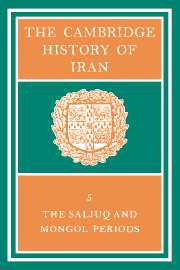Book contents
- Frontmatter
- 1 THE POLITICAL AND DYNASTIC HISTORY OF THE IRANIAN WORLD (A.D. 1000–1217)
- 2 THE INTERNAL STRUCTURE OF THE SALJUQ EMPIRE
- 3 RELIGION IN THE SALJUQ PERIOD
- 4 DYNASTIC AND POLITICAL HISTORY OF THE IL-KHĀNS
- 5 THE ISMĀ‘ĪLĪ STATE
- 6 THE SOCIO-ECONOMIC CONDITION OF IRAN UNDER THE ĪL-KHĀNS
- 7 RELIGION UNDER THE MONGOLS
- 8 POETS AND PROSE WRITERS OF THE LATE SALJUQ AND MONGOL PERIODS
- 9 THE VISUAL ARTS, 1050–1350
- 10 THE EXACT SCIENCES IN IRAN UNDER THE SALJUQS AND MONGOLS
- Bibliography
- Index
- Plate section
- References
4 - DYNASTIC AND POLITICAL HISTORY OF THE IL-KHĀNS
Published online by Cambridge University Press: 28 March 2008
- Frontmatter
- 1 THE POLITICAL AND DYNASTIC HISTORY OF THE IRANIAN WORLD (A.D. 1000–1217)
- 2 THE INTERNAL STRUCTURE OF THE SALJUQ EMPIRE
- 3 RELIGION IN THE SALJUQ PERIOD
- 4 DYNASTIC AND POLITICAL HISTORY OF THE IL-KHĀNS
- 5 THE ISMĀ‘ĪLĪ STATE
- 6 THE SOCIO-ECONOMIC CONDITION OF IRAN UNDER THE ĪL-KHĀNS
- 7 RELIGION UNDER THE MONGOLS
- 8 POETS AND PROSE WRITERS OF THE LATE SALJUQ AND MONGOL PERIODS
- 9 THE VISUAL ARTS, 1050–1350
- 10 THE EXACT SCIENCES IN IRAN UNDER THE SALJUQS AND MONGOLS
- Bibliography
- Index
- Plate section
- References
Summary
THE MONGOL INVASION
The chronology of Sultān Muhammad's first contacts with the Mongols is extremely confusing, and it is difficult and sometimes impossible to reconcile the accounts of the various authorities. According to Jūzjānī relations had been established as early as 1215. Himself attracted by the riches of China and therefore disturbed by reports of Chingiz-Khan's operations in that region Muhammad decided to send an embassy to this new rival with instructions to ascertain his military strength and the extent of his successes. The embassy was headed by one Bahā' al-Din Rāzī, and Jūzjānī professes to give his somewhat lurid account of the mission in the envoy's actual words. As the party journeyed through the North China plain they descried in the far distance a great white mound, which they took to be a snow-covered mountain but which, as they were informed by their guides, was in fact a huge pyramid of human bones. As they proceeded farther the very ground beneath their feet became dark and greasy from the fat of rotting corpses; and for three full stages they had to make their way through this grisly morass. When they finally arrived before Peking they perceived, beneath a bastion of the citadel, the bones of 60,000 young women who, when the city was captured, had flung themselves from the walls rather than fall into the hands of the Mongols. During the envoys' first interview with Chingiz-Khān the Chin Emperor's son and prime minister were brought in bound in chains, no doubt with an eye to the effect of this spectacle upon the ambassadors.
Keywords
- Type
- Chapter
- Information
- The Cambridge History of Iran , pp. 303 - 421Publisher: Cambridge University PressPrint publication year: 1968
References
- 39
- Cited by

